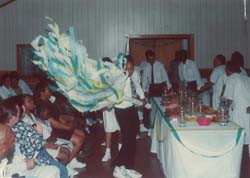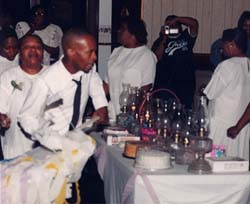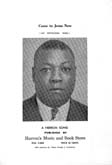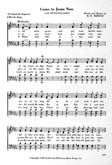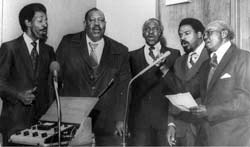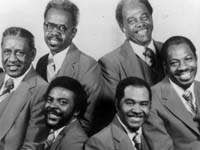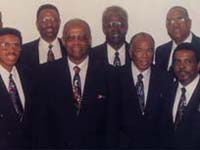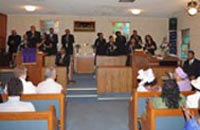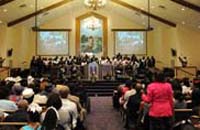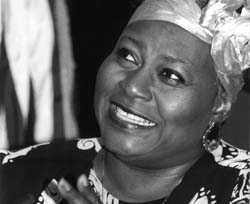Songs of Spirit and Continuity of Consciousness: African American Gospel Music in Louisiana
By Joyce Marie Jackson
The African American gospel idiom has contributed tremendously to Louisiana's unique musical heritage. It is a synthesis of African American music, dance, poetry, and drama distilled into a unified whole—a culmination of the African American religious and aesthetic experience which reveals strong connecting links to African roots in subtle and sometimes obvious ways. Gospel music is strongly entwined and entrenched in the black "folk" church tradition; however, it also attracts many supporters who identify with its message as much for its expression of African American values, aesthetics, and life experiences as for its expression of religion. Cultural participants in the tradition readily identify the historical, social, cultural and spiritual dimensions of this musical form. These views have been expressed among performers of varying degrees of expertise, experience, and popularity, and among listeners from a wide range of ages, denominational affiliations, and geographic locales.
As many students of religion have pointed out, the black "folk church" has historically represented the one and only cultural institution through which African Americans have been able to express themselves freely and without constraint (Mays and Nicholson 1933; Lincoln 1974; Nelsen and Nelsen 1975; Frazier 1975). It was in the context of black folk religions that the gospel music tradition evolved, serving as a personal and collective response to extrinsic and intrinsic environmental factors in the African American community. As the music developed it exhibited the most salient African-derived aesthetics. In concept and practice there has been some, but little significant deviation in gospel from many of the fundamental elements found in the traditional music of West Africa.
Since the church is the most conservative institution in the African American community, it is logical to assume that ritual services including the mode of worship and style and function of music would be preserved in their truest form. Many cultural ties of the African ancestral lineage have been maintained within the enclave of the black folk church. Pearl Williams-Jones characterizes the black folk church:
The black folk church is at once a mystical, invisible body of believers unified by a common Christian theology as well as a visible body and community of Black people united by common cultural ties. We may consider the Black folk church as being an institution controlled by Blacks which exists principally within the Black community and which reflects its attitudes, values and lifestyle. It is a church of every-day people and one of any denomination. . . . (1977:23).
Many of the ritual practices which we commonly associate with the black folk church, such as freely structured services, dance, improvisational music, emotional and musical delivery style of sermons and prayers, and spontaneous verbal and non-verbal responses by preachers and congregations have essentially emerged from African values and aesthetics.
In order to gain a true understanding of gospel music, the ensuing discussion will first explore these African values and aesthetics and how they influenced African American religion and subsequently gospel music. It is also necessary to establish the conceptual link between the spiritual and gospel music in order to understand that the aesthetic values and practices intrinsic to the gospel music tradition do not represent a break with the traditional past. On the contrary, the gospel music tradition is absolute evidence of the existence of a continuum in African American music, and a "continuity of consciousness," flowing through various aspects of African American culture (Levine 1977:174). Second, the discussion will focus on how this musical tradition has been manifested through African Americans in Louisiana.
The music created by African American slaves before and after the Civil War reflected their status and served as a response to the environment that controlled their lives. This religious music later known as folk spirituals was the 18th century creations of African American slaves who sought to express their religious beliefs in a way that was uniquely meaningful to them. The slaves created the folk spirituals, commonly referred to as "Negro Spirituals," in contexts free of white control. The spirituals came into being following the conversion of a significant number of slaves to Christianity. These songs commented on their love for God, the desire for freedom, the total disdain for the institution of slavery and their plans for secret meetings or escape as expressed in the familiar lines, "Steal away to Jesus, I ain't got long to stay here," or "Follow the drinking gourd."
The structural form and performance style associated with folk spirituals are derived from West African musical practices. In West Africa, the geographical origin for most of the slave population, cultural mores govern group singing at a musical event. These principles require the participation of group members who are present. Individuals become involved either by singing, dancing/shouting, handclapping, foot stamping, or some combination of these. These practices also provided the accompaniment.
Many accounts confirm that the spirituals were not at first a part of the formal services but belonged to the shout that took place after these services when the benches were pushed back to the wall and the worshipers stood in the middle of the floor. The shouters were really in a sense dancers, forming a ring in which they circled in a kind of shuffling counterclockwise movement to the sound of singing, hand clapping and foot stamping on the floor which took the place of percussive drumbeats. The shout could last well into the night or all night, and, was viewed with disdain by pious whites as well as some blacks. The shout song, "Oh David" is a vivid example of the type of ringdance music that was performed during the antebellum era and is still being performed today by a group in Winnsboro, Louisiana. This community refers to this sacred ritual as the Easter Rock because they do it on the eve of Easter. A brief description follows:
A procession of twelve women starts from the back of the sanctuary, moving toward the center to encircle the table. In the earlier days these women were the elderly "mothers of the church" and were purported to be members of the benevolent society (Pollard 1997; Gregory 1962). As they process in a counterclockwise direction around the table, the rockers begin to sing the spiritual "Oh When the Saints Go Marching In" in a dirge-like style, and the surrounding congregation augments the singing. The entire ceremony is done a cappella, with only handclapping and foot stamping to accompany the songs. The leader of the procession carries the circular banner [symbolic of the cross] with streamers flowing from it, and twelve women follow, each carrying a burning kerosene lamp.
After circling several times, the women place the lamps [symbolic of twelve tribes of Israel] on the table in a straight line. They then repeat these actions to place the twelve cakes [symbolic of the twelve disciples] on the table. Traditionally, all the cakes had white icing, but now it is a mixture. While singing the same song and without missing a step, they continue to proceed around the table while someone passes the cakes to them through the door in the back of the church. They slowly place the twelve cakes on the table, and continue their marching around the table. After the cakes have all been placed on the table, the rockers make a few more rounds. Then the tempo accelerates, the song changes, and the steps of the rockers quicken and change.
At this key moment, the rockers are transitioning into the second and heightened phase of the Rock. Now they begin to sing, "Oh David," an old up-tempo spiritual that is no longer performed except for this ritual. Since this spiritual is faster, the rockers began to move more quickly, performing the distinctive rocking step. This step constitutes a step-slide and skip from one side to the other and some participants do the steps without taking their feet off the floor. This phase of the Rock can continue indefinitely with practitioners alternating between sitting and rocking. In an older time, the ritual continued until the "sun shouted," or sunrise. Even now, this second phase is highly charged with emotion, where some of the rockers and congregants "catch the spirit," either shouting or going into trance. The repetitive rhythm that the congregants feet make while dancing or rocking around the table is the equivalent of the driving percussive texture of the African drum. In the Rock, as is in many African-derived sacred rituals, repetitive beaten rhythms whether from the drum or the sound of the feet on a hard floor, have a tendency to cause some participants to shout, go into trance, or invoke the spirit. After the Rock has gone on for quite some time, the song may be changed to, "Elijah Rock." It depends on who is leading the song and sometimes who is carrying the banner at the time. However, this does not mean that the banner carrier always leads and determines the song.
After the rockers have circled for an undetermined length of time depending on the movement of the spirit or degree of fatigue, they cease rocking for a while and subsequently resume the program (Jackson: 2005).
This type of animated and emotional ritual was valued by the slaves so much that many would risk being beaten or killed in order to worship in this manner which was very similar to their African performance aesthetics. As you can see, it is still valued today, but somewhat embellished with the various Christian and African-centered iconic symbols placed on the table altar. In the antebellum period, these rituals happened spontaneously when the opportunity presented itself in the slave quarters, but in the post-bellum years and today, these rituals are continued because they are consciously organized by members of the community, like Hattie Addison and her family from Winnsboro. Numerous instances have also been cited by travelers, journalist and ex-slaves that lived during the antebellum era (Levine 1977; Lovell 1972; Epstein 1977; Courlander 1963). Many of their meetings took place in undisclosed "praise houses"1 deep in the woods at night. One account of an independent testimony of an ex-slave regarding the drive for emotional expression follows:
Referring to a plantation located in Louisiana, Mrs. Channel says: "On this plantation there were about one hundred and fifty slaves. Of this number, only about ten were Christians. We can easily account for this, for religious services among the slaves were strictly forbidden. But the slaves would steal away into the woods at night and hold services. He [the speaker] would bend forward and speak into or over a vessel of water to drown the sound. If anyone became animated or cried out, the others would quickly stop the noise by placing their hands over the offender's mouth [or put the offender's head over the vessel]" (Herskovits 1941:210).
The concept of emotional group participation is further reinforced in the structural formula of the song itself. The songs, spontaneously created by an individual and/or group, were sung in an emotional antiphonal style of an unpredetermined length. Throughout West Africa, many songs subscribe to the antiphonal, call-response or leader-chorus structure, where the leader spontaneously improvised text, time and melody and the remaining group members respond with a short repetitive phrase which can also be expressed by making slight changes in time, text, or melody.
The antebellum folk spiritual is based on this same call-response structural principle—one which allows for latitude and flexibility on the part of the leader (the call/solo), and at the same time allows other group members to participate by singing short repetitive responses (response/chorus). Although occasionally some of the songs are sung in harmony, singing in unison appears to have been more common. When deviation from the basic melody occurs, the resulting sound is known as heterophony.
Repetitive texts were spontaneously improvised and sometimes taken from other genres including African songs, Protestant songs, and work songs. Other texts were drawn from vocabulary and phrases from the Bible, phrases from sermons, and everyday life experiences of slaves. Many of the spirituals were communally conceived and performed; however, individuals sang them also as a form of personal expression and communication with God and each other.
During the antebellum period, the song form associated with African American religion was the folk spiritual; its modern day counterpart is gospel. The unaccompanied folk spiritual served as the most important African American musical tradition up to the Civil War. After this period, this sacred music of sorrow, rebellion, and hope was transformed along with the slave populace. The folk spirituals were a profound expression of African American desire and ability to demonstrate their unique world view—their definition, understanding, and interpretation of the world that surrounded them. This same ideological principle was operative when they migrated to urban centers and created the gospel idiom.
Prior to the early 20th century most African Americans lived in the rural South. However, with the outbreak of World Wars I and II, the urban centers held a promise of economic and social opportunities and personal freedom for southern rural blacks. They came in hope of escaping a legal system of discrimination that prevented any improvements of their status. Unfortunately, life in the city did not meet the expectations of the migrants.
African Americans acknowledged the complex adjustments required in migrating from an agrarian context to an industrial one—from an overtly racist environment to one which covertly sanctioned the same "Jim Crow" statues. The practice of discrimination in employment, housing, education and the use of public accommodations forced African Americans to create an alternate life style.
A new gospel music more suited to urban life replaced the rural traditions such as the folk spiritual and gave a sense of pride and hope to those who had recently uprooted themselves in pursuit of a dream which seemed increasingly difficult to attain. African Americans confronted this difficulty through the process of consciously recreating those rituals, continuing those performance practices, and maintaining those values and aesthetics which were at the focal point of their mental and physical survival in the rural South.
They had to unite, and once more, the most important context for this union was the black folk church—not the 20th century middle-class oriented, mainstream establishment churches, but the small "storefront"2 churches (worship services held in abandoned stores or warehouses which were mainly Holiness or Pentecostal in the early 20th century but eventually encompassed more established denominations like Baptist and Methodist). The "storefront" churches were the modern day counterpart to the "praise houses" of the institutionalized slavery era. These churches were free of the rules of formality which characterized the mainstream denominations and their official doctrine encouraged freedom of expression which was manifested in the form of spontaneous testimonies, prayers, and praises from individuals. The congregants were committed to worshiping in this manner despite negative evaluations from outside sources (Hughes 1926; Huggins 1976).
There are many accounts describing the musical practices which played such a significant role in the ritual services of these churches (Bontemps and Conroy 1945; Stoddard 1971). Mahalia Jackson, gospel contralto, lived next door to a sanctified church in the city where she was born, New Orleans, Louisiana. She recalls the nature of the services and acknowledges the profound effect this exposure had on her development as a gospel musician:
These people had no choir and no organ. They used the drum, the cymbal, the tambourine, and the steel triangle. Everybody in there sang and they clapped and stamped their feet and sang with their whole bodies. They had a beat, a powerful beat which we held onto from slavery days, and their music was so strong and expressive it used to bring tears to my eyes (1966:32).
Although many elements of the folk spiritual became the foundation of gospel music, the instruments were a new addition; however, the behavior which accompanied it was not. The handclapping, foot stamping, and body movement that had been integral characteristics of the folk spiritual were maintained in the new gospel music performance style. Even though the physical context of the religious ritual service was no longer the same, the spiritual needs of African Americans had not changed.
Over the years, gospel music evolved to encompass many traditions and genres of music—from spirituals, hymns, and blues, to contemporary jazz, soul, and now rap. The historian Lawrence Levine contends:
While the message of black gospel music manifested a high degree of acculturation to a modern religious consciousness, its style and performance were being revitalized by an intensified connection with the roots of traditional Afro-American religion and the sounds and styles of the twentieth-century secular music of the black community. . . . (1977:189)
Most songs are composed by a single person; this concept of individual authorship is primarily European. The compositions are rarely performed as written, but are transmitted aurally which is the reason they are classified as composed folk songs. The written manuscript serves as merely a framework for personal interpretation and improvisation. Singers may delete notes, add new ones, intersperse shouts, testimonies, and vary the music as they deem necessary according to the dictates of their feelings, the "movement of the spirit," and/or the congregation. It is an ongoing process of creation and re-creation of a song, another form of acculturation. Levine comments on this process:
Acculturation as symbolized by developments in language, religion, and . . . secular song, was not merely the emergence of the new but the revitalization of the old. It has been a dual process of creation and re-creation, of affirmation and reaffirmation, of looking both without and within the black community for the means of sustenance and identity and survival (1977:189).
One of the main elements in gospel performance is that of contrast—in both vocal and instrumental parts. Since the 1920s, instrumental accompaniment has been added to the traditional handclapping and footstomping. Instruments such as the piano and organ as well as a variety of horns, percussive, and modern electric instruments (i.e. synthesizer) provide a driving, percussive, and polyrhythmic accompaniment for the melismatic and emotional vocal style characteristic of gospel performers (Williams-Jones 1970:211). The use of these instruments and the voice can create many tonal contrasts within a single piece through the process of improvisation. Wider based harmonies with voices and instruments also add to the important element of contrast. In addition, the use of various vocal timbres such as falsetto in the male voice, chest in the female, and the quasi-preaching style used by both is very important to obtain a dramatic concept, which is highly valued. These many-voiced textures and rhythms create an interweaving and layered effect for the listener which is also a primary aspect of the African performance aesthetic.
The structure of gospel songs also emphasizes contrast. Similar to the folk spiritual tradition, call-response structure can be found in many gospel tunes. A vocal soloist may alternate with the choir, singing verse-chorus, or chorus-verse. Another key feature is audience participation. People in the audience are usually encouraged to join in the song—whether in a call-response situation, or together as one chorus.
Another important component is visual image. Gospel performers as a whole are aware that the visual image they project to the audience is very important in their overall performance, because the visual image reaches the audience before the sound. Gospel choirs and groups wear colorful robes, formal gowns, or suits of the same color or design, which identify them as a cohesive group. Dress and color contrast is also used to define the hierarchical status of group members (Burnim 1980:155). Although performance attire may be viewed as an extrinsic or non-musical factor, it is highly valued among African Americans as another vehicle for cultural expression. The wearing of ceremonial attire in vivid color for performance is another continuum from African traditional customs.
Many forms and structures characteristic of the gospel tradition may be evident in other non-African American musical styles, but the conceptual usage of them represents a continuation of musical practices that originate from an African musical heritage.
Evolution of Gospel in Louisiana
Gospel music was pioneered in Philadelphia during the early 1900s by Charles A. Tindley. In Chicago during the late 1920s and 30s, an ex-blues pianist, Thomas A. Dorsey developed and popularized the form. During the years of the Great Depression, Dorsey, who is now commonly recognized as "the Father of Gospel Music," established the foundation and style for an original 20th century form of African American religious music. He captured the spirit of the urban lifestyle and gave the people an expression of hope and inspiration through his music—both in his musical style and in the vernacular lyrics to his songs.
As Dorsey started his crusade for gospel music and to popularize his songs, he travelled widely to various churches and religious conventions. He hired women (i.e. Sallie Martin, Roberta Martin, Mahalia Jackson et. al.) to perform his songs as he accompanied them on piano and also conducted choir workshops at the annual Baptist convention (first one was held in 1932 in Chicago).
Dorsey's crusade to disseminate gospel music was not only an important milestone in the historical development of the genre, it was also significant for the evolution of the tradition in Louisiana. It is problematical that little more than a beginning has been made in relation to research on African American sacred music in Louisiana, as compared to the secular music. The bulk of the research that has been conducted basically centers on the Florida Parishes3 and New Orleans. Therefore, most of the following discussion will focus on these areas.
In the middle 1920s, James E. Gayle organized the Gayle Jubilee Singers and established the James E. Gayle and Sons Music Store. For over two decades Gayle had the monopoly on selling published religious music, tracts, books, and Bibles from the National Baptist Publishing Board in Nashville (Boyer 1987:1516). Since Dorsey made trips to New Orleans seeking agents to sell his published songs, it was inevitable that the two would meet. Boyer reports that Gayle met Dorsey in the middle 1930s:
He [Gayle] served as host to Dorsey and Sallie Martin (b. 1896) on their frequent trips to New Orleans to demonstrate his songs and organize gospel choirs. In the thirties he [Gayle] began composing gospel music and in 1940 when Sallie Martin and Kenneth Morris (b. 1917) opened their publishing company in Chicago, he entered a long time association whereby they would publish his music, and he would serve as their Louisiana agent. He supplied the emerging accompanied gospel singers and choirs with the newest gospel songs. (1987:16)
It was in the context of the Depression era that gospel music came to fruition with its major catalyst being Thomas Dorsey. However, the central distributor for the state of Louisiana was James Gayle and his establishment. Another was the Herron's Music & Book Store, located at 1201 America St. in Baton Rouge which supplied music, Bibles, communion items, robes, and educational tools and materials for Sunday and Bible School for many churches as well as the church and choir conventions. Harvey H. Herron, the proprietor was also a musician and composed several gospel songs himself. "Do Not Let The Savior Pass You By" and "Come to Jesus Now" were two songs copyrighted by him and published by the Herron's Music and Book Store in 1946. In addition, he wrote and published other books including the Herron Choir Guide and Choral Directing Book and Herron's Usher Guide.
Although Herron's had a large collection of music by various gospel musicians including himself, Dorsey's compositions had a prominent position in his establishment. During this era in Louisiana as in other southern states unemployment was high and African Americans endured poverty and deprivation on a scale unprecedented since the abolition of slavery. Not only were they suffering from a lack of jobs, food, and clothing, but also from a lack of hope, dignity, and general well being. Gospel music directly addressed these needs. As Dorsey states, the songs communicated "good news in bad times" (Broughton 1985:48).
From Jubilee to Gospel
Even before Dorsey and Gayle, the first significant point in the development of gospel in Louisiana was the organization of a cappella jubilee quartets.4 The first documented a cappella quartet to be organized at a university in Louisiana was at New Orleans University (presently Dillard University) in 1914. During this time the groups performed spirituals and art songs in the style of the Fisk Jubilee Singers, but in later years they began to add Protestant hymns and gospel songs. One quartet at Dillard, the Frederick Hall Quartet, changed its name to Delta Rhythm Boys and continued to perform after they left the university. They traveled widely and began to add secular songs to their repertoire (Ebony Nov. 1953:114-16).
Southern University, first established in New Orleans in 1880 (main campus moved to Baton Rouge in 1914), organized a university quartet which was first recorded in 1935. The Southern University Quartet was recorded by Bluebird Recording Company on a field trip with a mobile recording unit (Godrich and Dixon 1982:11, 13).5
In the late 1930s and early 40s, Reverend James B. Offlee, now leader and manager of the Zion Travelers Spiritual Singers, was influenced by Reverend White, who was then a member of the school glee club at Southern University in Baton Rouge, Reverend Offlee recalls:
When I was real young I listened to Reverend White, he was singing at Southern in a glee club. And then from that he started singing at Mount Pilgrim [Baptist Church]. I use to like his singing, and from that I joined the choir under his administration. (Jackson 1988: 70)
The university jubilee quartets and ensembles influenced the development of some of the independent community-based quartets. The community-based groups were not formally connected with the educational institutions, although some were started by, and drew part of their membership from university singers. Others were organized in churches, by family members and at the occupational workplace.
In the rural areas surrounding New Orleans, one of the major farm crops was sugar cane; therefore, there were several sugar refineries in the region. The American Sugar Refinery in Arabi (rural area near New Orleans) was the founding workplace for the Four Great Wonders Quartet. James Payne began harmonizing with friends from his neighborhood who were also fellow workers at the sugar refinery (Abbott 1983a:31).
Professor J. W. Williams, an itinerant chorister who, like Payne, moved to New Orleans from rural Mississippi in the 1920s seeking employment, also found himself at the American Sugar Refinery. (He later founded a music school in New Orleans.) It was here in 1934 that he witnessed the birth of what would become the Four Great Wonders Quartet:
That's how they started, harmonizing on the job. . . . They'd start work 7:30 in the morning. And they would work till 12:00. . . . Then they'd have an hour for lunch; they'd run eat a little bit, then get behind a pile of sugar and start harmonizing . . . . (Abbott 1983a: 32).
The style of these early community-based jubilee quartets encompassed a well-blended close four-part harmony sound, a limited amount of solo singing, basic harmonic arrangements, and no instrumentation. They sang spirituals, jubilees, and hymns in the traditional call-response structure. Other male quartets in New Orleans that performed in this earlier jubilee style were the Osceola Five, the Second Zion Four, the Duncan Brothers, and the Humming Four (Abbott 1983).
This tradition was primarily male dominated; however there were some females who dared to adopt the repertoire, four-part close harmony voicings, and general stage manner and style of the male quartets.
Even voice classification was borrowed from the male tradition, and hence a number of outstanding female baritones and basses emerged during the thirties and forties. One of the first and most outstanding female quartets was the Southern Harps, organized in 1934 by Alberta French Johnson, Johnson, who came from a musical family—her brother was jazzman Albert "Papa" French—was able to attract a number of gifted singers to her group. . . . (Boyer 1987:10)
One of those gifted singers was Bessie Griffin, who went on to gain fame in Chicago as one of the members of the Caravans and later as a gospel soloist. The Southern Harps recorded "What A Friend We Have in Jesus" on the King label in 1947 while on a concert tour in New York. Another female quartet from that era recorded "Heaven Bound Train" in 1949. This group, the Jackson Singers was organized in 1936 by Alma Jackson (Boyer 1987:10; Abbott 1985).
In the late 1930s and 1940s when women were just beginning to perform in this tradition, buying power increased, and technological advances, such as the radio and phonograph profited considerably. It was during this period that a major stylistic transition began to take place in the quartet tradition, as many jubilee quartets became gospel quartets. This stylistic transformation consisted of innovative strategies, including the lifting of prior harmonic and vocal restraints, the increased prominence of the bass voice and soloist, the addition of a fifth singer, the introduction of a varied repertoire and the use of instrumental accompaniment.
Two of the most notable quartets to come on the New Orleans sacred music scene in the late thirties were the Soul Comforters and the Zion Harmonizers. The Soul Comforters (formally the New Orleans Humming Bees) began as a "doo wop" group harmonizing the latest popular songs on the street corners. After singing sacred music for a while, one of the original members, Henry Byrd changed his style and left the group. He later became the legendary rhythm and blues pianist, "Professor Longhair" (Boyer 1987:11; Abbott 1985).6
The Zion Harmonizers formed in New Orleans in 1939, enjoyed their 50th year anniversary in 1989. The group was lead by Sherman Washington for over 60 years and he was also a Sunday radio disc jockey and the director of the New Orleans Jazz and Heritage Festival Gospel Tent, one of the largest at the festival. The Zion Harmonizers is still a very vibrant and popular group in the city and at the festival. The popularity of the group may be related to their adaptability over the years the Zion Harmonizers have chosen to modify their performance style according to the dictates of a given audience. Such modifications include incorporating an instrument, a lead guitar, into their performance. They have also added the hard shouting gospel style of singing, while still continuing to perform select numbers in the a cappella jubilee style. The Zion Harmonizers changed where change was indicated, even as the Zion Travelers from Baton Rouge refused to modify their style regardless of audience composition or contextual setting (Jackson 1988:14-15).
Both groups have been involved in radio broadcasting. In fact, the Zion Travelers have been broadcasting on radio station WIBR, in West Baton Rouge every Sunday morning for over forty years. In 1956 the Harmonizers performed a regular live broadcast on station WMRY for Schiro's Shoe Store. Now, they perform periodically for WYLD where Sherman Washington, their leader once worked as a disc jockey for the gospel programming on Sunday mornings (Jackson 1988:16). The New Orleans Chosen Four/Soproco Singers also broadcasted live on radio.7 Their WWL broadcasts carried them into 32 states and yielded numerous invitations for concerts. According to the Louisiana Weekly, the group made its official debut in 1940 in a "City-Wide Singing Contest" (Abbott 1983:59).
The singing contest or "song battles" as many participants called them, are a very important component of the quartet tradition. These contests functioned primarily to promote and maintain high standards of quartet musical performance. The event provided a forum for sharing collective expressive behavior and aesthetics in the community. Thus, it created a sense of identity in individuals and a sense of unity in groups of people who could relate to the same cultural values reflected in the performance (Jackson 1988). Many quartets participated in these events including those previously mentioned, the Mighty Chariots of New Orleans, the Lighthouse Gospel Singers of Baton Rouge, the E F Five (East Feliciana) of Clinton and many others.
The performance practices, musical arrangements, and popularity of the traditional gospel quartets had a major influence on the emerging rhythm and blues and popular-styled vocal groups that began to appear after World War II. New Orleans was known as a jazz and rhythm and blues city, but this secular music was greatly influenced by gospel. Most members of the first rhythm and blues vocal groups were gospel performers before shifting to its secular counterpart. Record producers in New Orleans began to incorporate this gospel sound into the secular commercial music. In 1949, Imperial Records began recording Fats Domino and became one of the three top recording companies while New Orleans became one of the major rhythm and blues recording centers (Maultsby 1986:12).
A number of African American quartets in the Delta started with the shape-note system. This is a system of notated music commonly using four or seven shapes in lieu of the round notes found in standard European notation. This singing school system facilitates learning the music by note. The Pleasant Star Singers, formed in 1946, one of the oldest a cappella quartets in the Winnsboro, Louisiana area, still sing with the singing conventions. The Convention Specials Quartet (with members from various Delta parishes), the Mighty Soul Guides, and the Royal Newtown Spiritual Quartet from Monroe can usually be found at church programs and quartet anniversaries.
Other quartets organized after World War II reflected the new mixture of sacred and secular styles. The secular performers adopted not only its vocal and instrumental styles but also arrangements, call-response structure, group makeup, and stylized movements. Because rhythm and blues was more lucrative and popular, some quartets "crossed over" or performed on "both sides of the fence." For example, when the Delta Southernaires crossed over to secular music they called themselves the Spiders; when the Humming Four sang on secular programs they referred to themselves as the Hawks (Abbott 1983:n.p.).
The sacred/secular dichotomy has been a primary factor in determining the image and identity of the quartet within the African American community. Although a distinction exists between both realms, there is a degree of flexibility. Some secular music is performed by sacred quartets and on the other hand, some sacred music is performed in secular contexts. First Revolution, a young gospel quartet in New Orleans performs in both sacred and secular contexts. Their performance venues range from churches to parks, cafes, restaurants, nightclubs, and literally to the streets. They have performed in the French Quarter at Jackson Square (park), Storyville Jazz Hall (nightclub) and on Bourbon Street. When asked his opinion concerning performing sacred music in secular settings, Larry Bell, lead vocalist and manager of First Revolution replied:
Well I don't have any regrets on it because from reading the scriptures [the Bible]. . . . The thing that sticks in my mind on this is when they had a controversy when Jesus visited Matthew at his home. The words came out that folks that are not sick don't need the doctor. So I can't work on a patient if he is already well (Jackson 1988:82-83). 8
This is not a new concept, some gospel pioneers made this radical step at a very early stage in the history of the tradition. For instance, the Dixie Hummingbirds have their view of "playing" nightclubs. One member recalls: "We played our first night club [sic] at Number 2 Sheridan Square in New York in 1939" (Hummingbirds 1978:65). They believe different formats and contexts can be used to entertain as long as you "never get off the spiritual track." Other performers who made this radical move in the early years were Clara Ward and the Clara Ward Singers, Sister Rosetta Tharpe, and the Staple Singers. Some gospel singers believe that you should sing whenever and wherever you have an audience that is receptive to you.
This sacred/secular dichotomy is also evident in the Gospel/Blues Club that opened on Bourbon Street in the French Quarter in 1990. In this club, gospel performers are featured in the early evening and after a certain time bluesmen are showcased. The more religious gospel performers claim that even in secular settings you can still bring the message of God to the people and it will be heard regardless of the context. They also feel that communicating their spiritual message may even "cause someone to come to Christ."
In the late 1940s and early 1950s the male-dominated gospel quartet tradition began to decline and the female groups began to emerge. Previous female quartets had performed in the four-part male quartet style, while these newer groups sang three-part harmony arrangements accompanied by piano or organ. Female groups were organized and began traveling to help fill the increasing demands for this accompanied sacred music. In New Orleans the Johnson Sisters was one of the first accompanied female groups. This group, consisting of three sisters (Lois, Thelma, and Bernette) was organized in the middle 1940s (Boyer 1987:17).
Male and mixed accompanied groups were also formed during this time. In 1939 the Wilson-Watkins Singers were formed with Frank Williams as their accompanist. He later opened the Williams School of Music in 1947 where he taught classical and gospel piano. James E. Gayle organized the Gayle Jubilee Singers in the middle 1920s and at this time they were singing only spirituals and art songs. It was not until the middle 1930s when he met Thomas Dorsey and Sallie Martin that he began to add gospel music to his group's repertoire, however, he never stopped his performance of spirituals (Boyer 1987:16-17).
Praise And Worship Choirs
Despite the popularity of quartets, groups, and soloists, gospel choirs became prevalent in the late 1940s and early 50s. However, in New Orleans during the 1930s, Jackson Acox included gospel songs in the repertoire of St. Marks Fourth Baptist church choir, of which he was director. In addition, Professor J. W. Williams, director of the Old Zion Baptist Church choir, included gospel songs in their repertoire in the early 1940s (Williams 1983). It was not until 1948, when Williams organized the Southland Gospel Chanters that he caused a major change in the course of historical development of gospel music in New Orleans.
The Southland Gospel Chanters featured gospel songs of Thomas Dorsey and other composers of this era, including Professor Williams. The group consisted of young adults who traveled widely performing the music with much success. After the Chanter's success with the gospel sound, most African American Protestant churches in the city followed suit by organizing a gospel choir (Williams 1983). In the 1960s gospel choirs began to take on a new sound. They began to use more intricate harmonies than their predecessors and often sang in contrapuntal style with independent interplay between voices. In addition to the piano, electronic organ, and percussion instruments, a variety of other instruments were added. Horns, electric bass, and the drum set became popular, as gospel choirs moved closer to the secular music, called "soul," which had taken its initial style from gospel. The decade of the 1960s also ushered in the entrance of gospel music to the Civil Rights Movement. Some gospel composers began to replace Biblical themes by the utilization of timely topical text concerning social and political issues.
By the 1970s the gospel choral sound had evolved into two categories—traditional and contemporary. This became evident, in most churches with sizeable congregations, as the need arose for more than one choir. For example, at the Greater King David Baptist Church in Baton Rouge, pastored by John E. Montgomery, there are four choirs—Mass Choir, Male Chorus, the Youth Choir, and the Cherubim Choir. They all sing traditional and contemporary songs. Occasionally they combine for a special celebration like the Christmas concert where they also perform with the Southern University orchestra. Large churches like the Greater King David Baptist Church and Shiloh Baptist Church in Baton Rouge and the Greater St. Stevens Full Gospel Baptist Church, in New Orleans, often have a large ministerial staff of highly trained musicians. For example, although Greater King David has one main minister of music, it has four directors, one for each choir and six to eight instrumentalist depending on what Sunday and who is performing. These choirs can also perform hymns, spirituals, and anthems along with traditional and contemporary gospel songs. In smaller churches similar to St. Mark Baptist church in Ferriday and Holly Grove Baptist Church in Zachary, the traditional styles still prevails. These smaller churches tend to adhere to older and more traditional religious and musical practices including traditional gospel, spirituals and hymns.
In Louisiana, the late 1960s and 1970s also witnessed the formation of gospel choirs in Roman Catholic churches. New Orleans has the largest predominantly African American parish in the United States and now holds the distinction of establishing the first gospel choir in a parish of this composition. St. Francis de Sales' gospel choir was organized in 1968 and is still one of the most notable choirs in the city. Other Catholic churches have also organized gospel choirs, including St. Joseph the Worker in Marrero and St. Monica in New Orleans.
In the 1980s there was a proliferation of community choirs. The Concordia Mass Choir in Ferriday, the Voices of Zion in Baton Rouge, and the Inspirational Youth Choir in New Orleans all perform traditional and contemporary songs. However, the one hundred voice Gospel Soul Children, who was directed by the late Albert Hadley in New Orleans, was the paramount exponent of contemporary gospel, often anticipating the newest direction of the genre in their performances.
Eunice Johnson and Elmore Waters introduced a project to save the youth in Shreveport. It was actually called "Save the Youth Mass Choir" and they recorded in the 1970s and 80s. Ms. Hattie L. Wade started the Youth Rally in Shreveport, which was the highlight of the city with youth of all denominations. She recalls: "With this group, I also started the City-wide Revival Youth Choir and they came from all over the city and some people drove from other cities to be a part of this choral celebration. This was during the 70, 80s and early 90s. We sang gospels, anthems, hymns and spirituals. I usually worked with 300-400 students at one time" (Wade: 2012).
After the Civil Rights Movement in the 1970s and 80s, some predominantly white universities in the north and the mid-west established African American studies programs and departments and/or African American cultural centers on the campuses as well as gospel choirs. It took the south a little longer to follow suit, so it was during the late 1980s and 1990s that universities in Louisiana (predominantly black or white) began to established programs in African American studies, cultural centers and gospel choirs. Reginald Collins established the Southern University Interdenominational Gospel Choir in 1989 while he was a Minister of Music at the Greater King David Baptist Church in north Baton Rouge. To him the members had to do more than sing, it was also a ministry, so they had Bible Study and did volunteer work in the community. Louisiana State University established its African and African American Studies Program in 1994, but had the cultural center prior to that and established a gospel choir in the late 90s. Grambling State University founded its gospel choir in the 1990s and Northeast University in Natchitoches as well as Louisiana Tech University in Ruston also established gospel choirs.
Gospel Divas
Gospel soloists permeated all the periods starting from the 1930s. Initially men soloists were not as strong, but more came into prominence as the style developed. Women always dominated this gospel genre. Of course the most well-known, even internationally, was Mahalia Jackson, who was born and raised in New Orleans. She left and migrated to Chicago where she soon became a soloist in her church and subsequently a soloist for Thomas Dorsey. She helped him to demonstrate his gospel music compositions and simultaneously made a prominent name for herself as a consummate gospel soloist. Over the years numerous recordings of her signature songs including performances of "Move on Up A Little Higher, " "Upper Room, " "Didn't It Rain, " and "If I Can Help Somebody," enhanced her stellar career of touring and bringing gospel music to the world stages. Jackson died in 1972 and was honored in Hollywood by having a star mounted for her on the Hollywood Walk of Fame. New Orleans has also honored their native daughter by dedicating and naming the city's new Performing Arts Theater in her honor. In addition, in 2012, the city and Xavier University celebrated her anniversary by having several programs including gospel concerts, film screenings, panel discussions, and guest speakers (one being Jackson's niece from Chicago).
There were other female gospel songsters in the New Orleans community that were stellar performers like Bessie Griffin, who by the way came to Los Angeles along with the Zion Harmonizers to perform when Jackson was honored with the star. Bessie Griffin gained fame first by singing with the famous Gospel Caravans in Chicago and later launched a solo career. Other highly gifted female singers who remained in New Orleans were Christine Myles and Rev. Lois DeJean, who recently performed and contributed to the celebration for Mahalia Jackson in 2012. Rev. DeJean remained in New Orleans and became a gospel music educator and choir director, while also establishing her own group called the Johnson Extension. Similarly in Monroe, Louisiana, Penola Caesar, a hair stylist, was an extraordinary gospel performer. Whenever she came to sing, audiences rejoiced. She also had her signature songs and became an educator of gospel music and long meter or Dr. Watts hymns. She conducted workshops on how to sing in certain sacred styles, because as she stated "the youth of our churches do not know them." Penola Caesar only recorded one CD, but she is remembered by her community because of her live gospel performances, traditional ways of educating the community, and her generous presence. She was referred to by the black Monroe community as "Our Mahalia."
The Hallelujah Radio Hour
Personalities other than performers in the gospel network are also very important for the maintenance of the tradition. Disc jockeys, booking agents, promoters, composers, and publishers play an important role in promoting gospel groups and programs not only in the African American community, but with the larger populace as well. Most radio stations programmed by African Americans have several hours per day designated for gospel programming.
On radio station WXOK in Baton Rouge, Eula Mae Hatter, better known in the community as "Cousin Carrey," has broadcast a gospel program since the 1950s. Everyone interested in "being in the know" about religious music and services tunes in to "Cousin Carrey," especially on weekend mornings. She gives a complete rundown on gospel programs and special church activities in the area, along with religious music and special requests for particular tunes. (Jackson 1989:102)
In the city of New Orleans, Vernon Winslow, affectionately known in the community as Dr. Daddy O, played this identical role for several decades.
Another confirmation of the importance of maintaining the music today is the growing prevalence of twenty-four hour gospel stations. In New Orleans WYLD and WBOK, which are both AM stations, have twenty-four hour gospel programming. In Baton Rouge, WNDC AM once honored this format and was operated by a church group in the community—Church Point Ministries. Within the last couple of decades, more stations are on the air with only gospel music for at least 18 hours. In Shreveport, Rev. A.S. Jackson did his broadcasts direct from churches and Pastor Blade broadcasted from KCIJ and had a program called The Hallelujah Train. This radio program featured more group oriented broadcasts including quartets and mixed groups.
There has also been a rise in gospel music publications. In New Orleans there are two monthly publications that have recently appeared in the community, the newspaper, Gospel Music Echo United Gospel Magazine. Though brief and without citations, these articles and news items are valuable because of their descriptive accounts of events and informative interviews with performing artists and groups.
Conclusions
There is no doubt that African American gospel music will continue to exist as a dynamic expression of the cultural identity of participants in the tradition. It is still one of the most genuine forms of the community's expression of values and aesthetics and has remained the least encumbered by Euro American influence. There is still a strong continuity of consciousness. In her chapter on Mahalia Jackson, Hettie Jones contends, "By the forties gospel music had become an institution in black communities. . . . Gospel music was a national affair, but a national Negro affair. . . . Gospel was private, African, Negro, black" (1974:81, 82).
Despite the influence and popularity of some performers, gospel music has remained essentially African American. This is due to the fact that the music is an intricate part and thus cannot be totally separated from the African American church and subsequently from centuries of the African American experience in America. Gospel music continues to speak to and for people of African descent in the vernacular as a dynamic form of folk creativity.
Notes
1. "Praise houses" and "hush harbors" were designated by slaves as places of worship. These worship settings, for example, could have been one of the cabins in the slave quartets or under one of the large oak trees in the woods. Many slave owners did not allow their slaves to worship; however, they continued to worship in a clandestine manner, thus the term "hush harbors."
2. "Storefront" churches were abandoned stores or warehouses where worship services were held. This practice became prevalent in the early 20th century after African Americans arrived in urban centers seeking a place to hold worship services.
3. The area designated as the Florida Parishes fell within the Spanish territory of West Florida in 1810. During this time it comprised the area of Louisiana north of Lake Ponchartrain, east of the Mississippi River and south of the Mississippi border. Today this area encompasses eight parishes—East and West Feliciana, East Baton Rouge, Livingston, St. Helena, St. Tammany, Tangipahoa, and Washington. This area is referred to as the Florida Parishes in recognition of its history.
4. The term "jubilee" has various meanings depending on context and the period of history that it is used in. It has been used to designate rejoicing songs of freedom, special celebrations, religious narrative songs, a body of black religious folk songs, the style that the songs are performed in and the groups that sing these songs.
5. The main campus of Southern University was moved to Baton Rouge in 1914; however, the board continued to maintain a branch of the campus in New Orleans. There is also a branch in Shreveport.
6. The respectful title "professor" or "fess" (shortened version) is given to African American musicians who have displayed a cultural competence in the performance of some form of African American music sacred or secular. It does not, in the vernacular, designate an academic degree.
7. The New Orleans Chosen Four is the same group as the Soproco Singers. Their name was changed when they began advertising for the Soproco Soap Company. In later years they changed the name back to the original one.
8. The scriptures from the Bible that Larry Bell was referring to were Matthew 9:10-13.
Bibliography
Abbott, Lynn. The Soproco Spiritual Singers: New Orleans Quartet Family Tree. Monograph published by Jean Lafitte National Historical Park, New Orleans, La. 1983.
____. "The Humming Four and the Hawks," Whiskey, Women and . . . 11 (June 1983): n.p.
Bontemps, Arna and Jack Conroy. Anyplace But Here. New York: Hill and Wang, 1945.
Boyer, Horace C. "Tracking the Tradition: New Orleans Sacred Music." Paper presented at a joint conference, College Music Society and the Black Music Research Center, New Orleans, Louisiana, October, 1987.
Broughton, Viv. Black Gospel: An Illustrated History of the Gospel Sound. Poole, Dorset: Blanford Press Ltd., 1985.
Burnim, Mellonee. "The Black Gospel Music Tradition: Symbol of Ethnicity." Ph.D. diss., Indiana University, 1980.
Collins, Reginald. December 2012. Personal Interview. Baton Rouge, Louisiana.
Courlander, Harold. Negro Folk Music U.S.A. New York: Columbia University Press, 1963.
DeJean, Lois. March 2011. Personal Interview, New Orleans, Louisiana.
Dixie Hummingbirds. "We're Celebrating Fifty Years of Gospel," Black Stars (November 1978): 64-65.
Epstein, Dena J. Sinful Tunes and Spirituals: Black Folk Music to the Civil War. Chicago: University of Illinois Press, 1977.
Franklin, E. Dwight. November 2012. Personal Interview, New Orleans, Louisiana.
Frazier, E. Franklin. The Negro Church in America. 1964. Reprint. New York: Schocken Books, 1975.
Gregory, H. "Africa in the Delta." Louisiana Studies 1(1):17-23.
Goodrich, John and Robert Dixon, comps. Blues and Gospel Records, 1902-1942. 1969. Reprint. Essex, England: Storyville Publications Ltd., 1982.
_____. "Gospel Singers," 6 (December 1950): 91-95.
Herskovits, Melville J. The Myth of the Negro Past. Boston: Beacon Press, 1941.
Huggins, Nathan. Voices from the Harlem Renaissance. New York: Oxford, 1976.
Hughes, Langston. "The Negro Artist and the Racial Mountain," The Nation 122 (June 1926).
Jones, Hettie. Big Star Fallin' Mama: Five Women In Black Music. New York: Viking Press, 1974.
Jackson, Joyce Marie. "The Changing Nature of Gospel Music: A Southern Case Study." African American Review 29, No. 2, (Summer 1995): 185-200.
_____. The Cultural Evolution of the African American Sacred Quartet, Saints and Sinners: Religion, Blues and (D)evil in African-American Music and Literature, pp. 97-112. Ed. by Robert Sacre. Liege, Belgium: Societe Liegeoise de Musicologie, 1996.
_____. The Gospel Train: Zion Travelers Spiritual Singers from Baton Rouge, LA. (Project Director and Co-Producer). Louisiana Folklife Recording Series #009. A documentary recording (cassette) and interpretive booklet, 1996. http://www.louisianafolklife.org/LT/
Articles_Essays/the_gospel_train.html
_____. Like a River Flowing with Living Water: Worshiping in the Mississippi Delta, Smithsonian Institution's 1997 Festival of American Folklife, pp. 31-35. Washington, D.C.: Smithsonian Institution Press, 1997. http://www.louisianafolklife.org/LT/
Articles_Essays/DeltaSIworship.html
_____. "Mahalia Jackson" In Black Women in American: An Historical Encyclopedia. Ed. by Darlene Clark Hine., pp. 620-623. New York: Carlton Publishing Co., 1993.
_____. "Music of the Black Churches." In Folklife in the Florida Parishes, 97-102. Baton Rouge and Hammond: Louisiana Division of the Arts Folklife Program and Center for Regional Studies, Southeastern Louisiana University. http://www.louisianafolklife.org/LT/
Virtual_Books/Fla_Parishes/book_florida_gospel.html
_____. "The Performing Black Sacred Quartet: An Expression of Cultural Values and Aesthetics." Ph.D. diss., Indiana University, 1988.
_____. Rockin' and Rushin' for Christ: Hidden Transcripts in Diasporic Ritual Performance, In Caribbean and Southern: Transnational Perspectives on the U.S. South. Anthropological Proceedings Vol. 38, ed. by Helen Regis. Athens: University of Georgia Press, 2006.
Jackson, Mahalia. Movin' On Up. New York: Hawthorn Books, Inc., 1966.
Levine, Lawrence. Black Culture and Black Consciousness. New York: Oxford University Press, 1977.
Lewis, Harold. Personal Interview with author. New Orleans, Louisiana, January 1983.
Lincoln, C. Eric. "Black Religion and the Black Church: Mode, Mood and Music: Humanizing the Social Order." In The Black Experience in Religion. New York: Anchor Press, 1974.
Lovell, John. Black Song: The Forge and the Flame. New York: Macmillan Co., 1972.
Maultsby, Portia. "Rhythm and Blues (1945-1955): A Survey of Styles." In Black American Popular Music, 6-19.
Mays, Benjamin and Joseph Nicholson. The Negro's Church. New York: Institute of Social and Religious Research, 1974.
N.A. "Musical Globetrotters: Delta Rhythm Boys Win Success in Countries All Over the World." Ebony Nov. 1953: 114-16.
Nelsen, Hart M. and Anne Kusner Nelsen. Black Church in the Sixties. Lexington, Kentucky: Univ. Press of Kentucky, 1975.
Pollard, M. Personal interview with author. Winnsboro, Louisiana, March 1997. Stoddard, Tom. Pops Foster: The Autobiography of a New Orleans Jazzman. Los Angeles: University of California Press, 1971.
Wade, Hattie, L. December 2012. Personal Phone Interview. Shreveport, Louisiana.
Williams-Jones, Pearl. "Afro-American Gospel Music." In Developmental Materials for a One Year Course in African Music for the General Undergraduate Student, edited by Vada E. Butcher, 201-219. Washington, D. C.: College of Fine Arts, Howard University and U. S. Dept. of Health, Education and Welfare, 1970.
_____. "The Musical Quality of Black Religious Folk Ritual," Spirit 1 (1977): 21.
Williams, John W. January 1983. Personal Interview. New Orleans, Louisiana.


